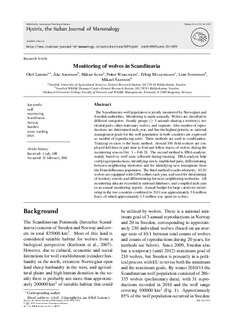Monitoring of wolves in Scandinavia
Liberg, Olof; Aronson, Åke; Sand, Håkan; Wabakken, Petter; Maartmann, Erling; Svensson, Linn; Åkesson, Mikael
Journal article, Peer reviewed

Åpne
Permanent lenke
http://hdl.handle.net/11250/134150Utgivelsesdato
2012Metadata
Vis full innførselSamlinger
Originalversjon
Liberg, O., Aronson, Å., Sand, H., Wabakken, P., Maartmann, E., Svensson, L., & Åkesson, M. (2012). Monitoring of wolves in Scandinavia. Hystrix - Italian Journal of Mammalogy. doi: http://dx.doi.org10.4404/hystrix-23.1-4670Sammendrag
The Scandinavian wolf population is jointly monitored by Norwegian and
Swedish authorities. Monitoring is made annually. Wolves are classified in
different categories. Family groups ( 3 animals sharing a territory), territorial
pairs, other stationary wolves, and vagrants. Also number of reproductions
are determined each year, and has the highest priority as national
management goals for the wolf population in both countries are expressed
as number of reproducing units. Three methods are used in combination.
Tracking on snow is the basic method. Around 100 field workers are employed
full time or part time to find and follow tracks of wolves during the
monitoring season Oct. 1 – Feb 28. The second method is DNA-analysis,
mainly based on wolf scats collected during tracking. DNA-analysis help
verifying reproductions, identifying newly established pairs, differentiating
between neighboring territories and for identifying new immigrants from
the Finnish/Russian population. The third method is radio telemetry. 10-20
wolves are equipped with GPS-collars each year, and used for determining
of territory extents and differentiating between neighboring territories. All
monitoring data are recorded in national databases, and compiled each year
in an annual monitoring reports. Annual budget for large carnivore monitoring
in the two countries combined in 2011 was approximately 5.8 million
Euro, of which approximately 1.5 million was spent on wolves.
Beskrivelse
This article is available in fulltext on the Hystrix Webpage